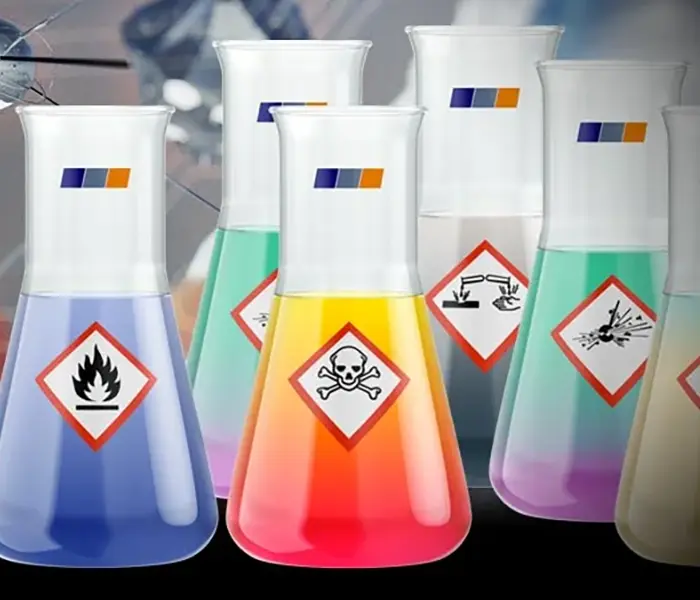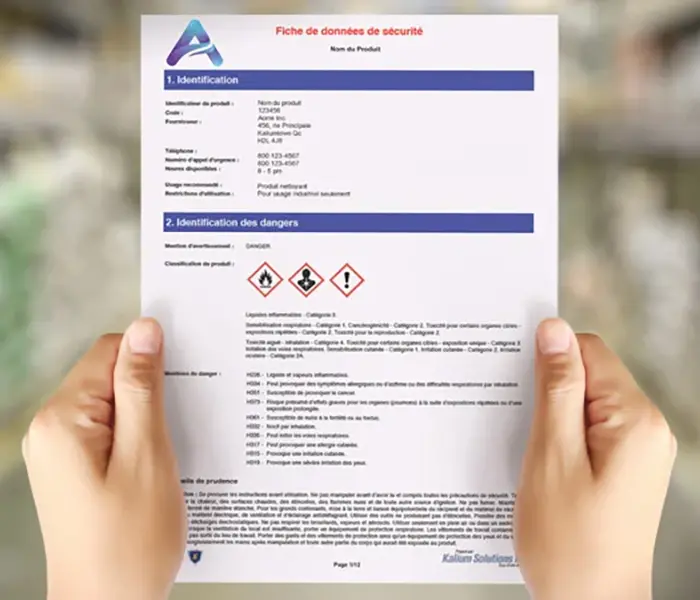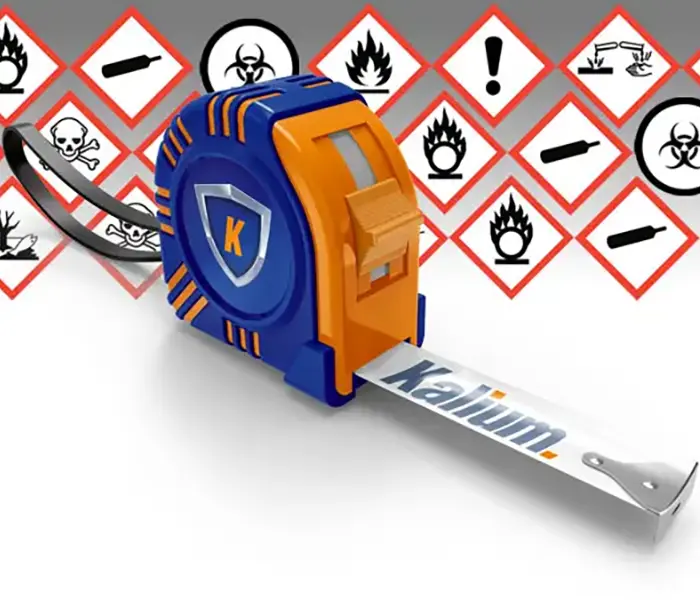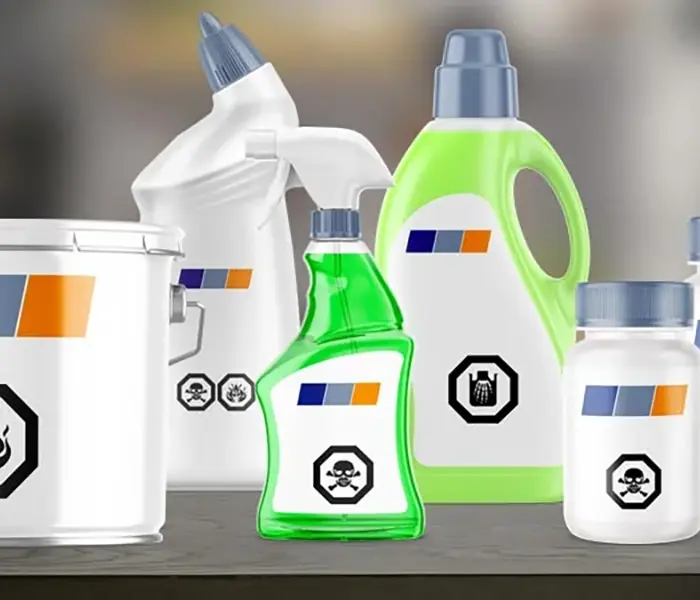WHMIS Training in Canada
Train your team to recognize hazards, read labels and SDSs, and meet Canadian OHS obligations. Our WHMIS training courses are available online or on-site and include full certification for workers, supervisors, and managers handling hazardous products. WHMIS certificates are provided upon completion.
Ready to Strengthen Your WHMIS Training Program?
Train your team, streamline your documentation, and keep your workplace compliant with expert guidance from Kalium Solutions. Whether you need WHMIS training, implementation support, or chemical safety software, our chemists are here to help. (CTA: Ask for a demo or contact an expert to get started today.)
Choose Your WHMIS Training
Select the WHMIS training that matches your team’s roles and risk profile. All courses are delivered by experienced chemists, available online (live videoconference) or on-site anywhere in Canada, and include a certificate of completion. Programs align with WHMIS 2015 / WHMIS 2022, the Hazardous Products Regulations (HPR) under the Hazardous Products Act (HPA), and best practices from Health Canada and CCOHS.
WHMIS 2015 TrainingGive workers the core competencies required to work safely with hazardous products. Participants learn how WHMIS fits within GHS, how to read supplier and workplace labels, and how to use Safety Data Sheets (SDS) to make safe decisions on the job. Outcomes:
|
|
|
|
SDS Interpretation TrainingBuild the ability to read and assess SDS quality so information is used correctly in your workplace. Ideal for supervisors, joint health and safety committees, and anyone who relies on SDS content in procedures or audits. Outcomes:
|
WHMIS Classification TrainingAdvanced training for professionals who need to classify products and prepare documentation. Covers sources of data, decision logic, and how WHMIS aligns with GHS and the OSHA Hazard Communication Standard (HCS 29 CFR 1910.1200) for cross-border operations. Outcomes:
|
|
|
|
Related Training & ServicesWHMIS Implementation ServicesGo beyond training with expert support to implement WHMIS across your organization. Kalium’s chemists and safety specialists help you review SDS inventories, create compliant workplace labels, and align your internal procedures with Health Canada and CCOHS guidance. CCCR Training (Consumer Chemicals)If your products fall under the Consumer Chemicals and Containers Regulations (CCCR, 2001), Kalium offers dedicated training on classification, labeling, and packaging rules for consumer products. This program helps manufacturers, importers, and distributors meet Health Canada requirements before going to market. SDS Authoring and Chemical Storage SolutionsStrengthen your compliance system with Kalium’s integrated software:
Together, these tools and trainings ensure your WHMIS program remains accurate, traceable, and audit-ready. (CTA: Ask for a demo) |
What is WHMIS?
WHMIS (Workplace Hazardous Materials Information System) is Canada’s system for classifying hazardous products and communicating risks to workers. It is aligned with the Globally Harmonized System (GHS) and implemented through the HPR under the HPA. WHMIS requires standardized labels, accessible SDSs, and worker education and training that are specific to the hazards present and the tasks performed. Employers must ensure training is provided and refreshed when conditions change or new hazards are introduced.
Hazard Classes and Pictograms
WHMIS uses standardized pictograms and hazard classes to convey risks quickly. Workers learn to recognize the symbols and apply the associated precautions.
Common pictograms and what they signal
- Exploding Bomb: explosives, self-reactives, organic peroxides
- Flame: flammables, pyrophorics, self-heating, emits flammable gas
- Flame Over Circle: oxidizing gases, liquids, or solids
- Gas Cylinder: gases under pressure
- Corrosion: skin corrosion, serious eye damage, metal corrosion
- Skull and Crossbones: acute toxicity (severe)
- Exclamation Mark: skin/eye irritation, skin sensitization, STOT (single exposure)
- Health Hazard: carcinogenicity, mutagenicity, reproductive toxicity, respiratory sensitization, STOT (repeated), aspiration hazard
- Environment: aquatic toxicity (may appear on supplier labels from other jurisdictions; not required for WHMIS workplace labels)
Training connects each pictogram and class to practical controls such as segregation, ventilation, PPE, and emergency response.
Why Organizations Choose Kalium for WHMIS Training
WHMIS Training Delivered by Experienced Chemists
Our instructors are practicing chemists who translate WHMIS 2015 / WHMIS 2022 requirements into day-to-day tasks. They use examples from manufacturing, labs, distribution, education, and public-sector operations so teams understand how labels, SDSs, and procedures apply on the floor.
Flexible, Bilingual Delivery Across Canada (Online or On-Site)
Train your workforce by live videoconference or at your facility anywhere in Canada. Sessions are available in English or French and can be scheduled around shifts so you can train entire crews without disrupting operations.
Role-Based WHMIS Courses With Certificates
Choose the path that fits the job: WHMIS 2015 Training for workers, SDS Interpretation Training for supervisors and JHSC members, and WHMIS Classification Training for professionals who determine classes and categories. Every participant receives a certificate of completion and employers receive documentation to support audits and due diligence.
Integrated With Your Chemical Safety Systems
Keep training consistent with your documentation by pairing it with Kalium’s SDS Management Software and SDS Authoring Software. When labels and SDSs match what employees learn, programs stay aligned across sites.
Practical, Inspection-Ready Outcomes
Courses emphasize reading supplier and workplace labels, using SDSs, identifying incompatibilities, and applying safe handling and storage. Guidance reflects Health Canada, CCOHS, TDG, and OSHA HCS principles so teams are ready for real work and real inspections.
Ready to Schedule Your WHMIS Training with Kalium Solutions?
Empower your team with WHMIS training developed and delivered by expert chemists. Available online or on-site across Canada, our bilingual programs keep your organization compliant, efficient, and inspection-ready.
WHMIS Hazard Classes
Since the Hazardous Products Regulations (HPR) replaced the Controlled Products Regulations in Canada, WHMIS primarily uses the United Nations Globally Harmonized System (GHS) pictograms. These pictograms—easy to recognize by their red diamond border—draw workers’ attention and indicate the hazards posed by products. These hazards are divided into two groups: physical hazards and health hazards.
Physical Hazards
Physical hazards are hazards that can cause damage to the immediate environment of the products through mechanical or chemical action. Physical hazards can also severely injure workers who are exposed. WHMIS groups physical hazards under five pictograms, plus hazards that do not require a pictogram.
Exploding Bomb![Exploding bomb pictogram]()
This pictogram warns the worker that the product presents an explosion risk—i.e., a chemical reaction generating gases at a rate, temperature, and pressure likely to cause damage.
Explosives are not regulated under WHMIS because they are governed in Canada by the Explosives Act. However, some substances that are not “explosives” under that Act can still present explosion hazards. The following WHMIS hazard classes require the exploding bomb pictogram:
- Self-reactive substances and mixtures – Types A and B
- Organic peroxides – Types A and B
When this pictogram appears on a product, all necessary precautions must be taken to prevent detonation or deflagration. Protect the product from heat, flames, sparks, static electricity, and shock. It must be protected from light and kept cool—often refrigerated in an explosion-proof refrigerator—and accessible only to trained personnel. Quantities stored in the workplace should be kept to a minimum.
Gas Cylinder![Gas cylinder pictogram]()
The gas cylinder pictogram is used when a product is a pressurized container, except for aerosols. It indicates the contents are under pressure and there is a significant risk of damage if the container is opened, damaged, or mishandled.
Compressed gas cylinders often carry this pictogram. If a cylinder fails, it can literally rocket and cause severe damage along its path. WHMIS hazard classes that require this pictogram include:
- Gases under pressure
- Compressed gas
- Liquefied gas
- Refrigerated liquefied gas
- Dissolved gas
- Chemicals under pressure
When handling, transporting, or storing a product with the gas cylinder symbol, avoid situations that could lead to container rupture. Cylinders must be kept upright and secured to prevent tipping. Keep containers away from heat and direct sunlight to avoid internal pressure increases that could lead to an explosion.
Flame![Flame pictogram]()
The flame pictogram covers the widest range of hazard classes in WHMIS. In general, it indicates a fire risk.
There are 11 distinct hazard classes associated with the flame pictogram:
- Flammable gases – Categories 1A, 1B; Chemically unstable gas A and B; and 1A Pyrophoric gas
- Aerosols – Categories 1 and 2
- Flammable liquids – Categories 1, 2, and 3
- Chemicals under pressure – Categories 1 and 2
- Flammable solids – Category 1
- Pyrophoric liquids
- Pyrophoric solids
- Self-heating substances and mixtures
- Substances and mixtures which, in contact with water, emit flammable gases
- Self-reactive substances and mixtures – Types B, C, D, E, F
- Organic peroxides – Types B, C, D, E, F
When handling products with the flame pictogram, keep them away from open flame, heat sources, and sparks. Take measures to avoid shock and static electricity. Avoid mixing these products with oxidizers, as such mixtures can greatly increase ignition risk.
Some of these substances require specific precautions—for example, pyrophoric liquids and solids must be kept under inert atmosphere. Substances that emit flammable gases on contact with water should be kept dry (e.g., in a desiccator) or submerged in oil to prevent contact with water or ambient humidity.
Storage for products with the flame pictogram is complicated by the wide range of hazard classes involved. Not all substances bearing the flame symbol are mutually compatible. Self-heating substances, for example, must not be stored with flammables. Because storage can be challenging, a more detailed assessment is often required to store these substances safely. In practice, it can be easier to base storage on Transport of Dangerous Goods (TDG) classifications.
Flame Over Circle![Flame over circle pictogram]()
The flame over circle pictogram represents oxidizing products. These are not themselves combustible but can cause or intensify a fire because they supply oxygen. Three hazard classes use this pictogram:
- Oxidizing gases
- Oxidizing liquids
- Oxidizing solids
Products with this pictogram must be kept away from flammables and combustibles. In a fire, if flames reach oxidizers, the fire will accelerate and intensify—something to avoid at all costs. Contact between oxidizers and flammables should also be prevented because it can cause a fire or even an explosion. Some oxidizers are so powerful they can ignite simple combustible materials (e.g., wood, paper) on contact. For this reason, oxidizers should not be kept in cardboard boxes or on wooden pallets and shelving.
Corrosion![Corrosion pictogram]()
The corrosion pictogram is the only WHMIS pictogram used for both physical hazards and health hazards. In this section, we address only physical hazards; health hazards are covered later.
For physical hazards, this pictogram represents products that damage metals through chemical action. One hazard class uses this pictogram:
– Corrosive to metals
When handling a substance corrosive to metals, avoid contact with metals. Clean up spills promptly to prevent the substance from reaching and attacking nearby metal structures. Ensure the storage or transfer container is corrosion-resistant. Do not store these substances in metal containers, which could fail and cause a spill.
Another key point: substances under the corrosion pictogram can be acidic, basic, or neutral/without pH. Acids and bases are incompatible. Storage must therefore keep these substances separated: mixing an acid and a base can cause a violent exothermic reaction. Heat generation can start a fire and eject unneutralized corrosives in all directions, multiplying harm and risk. Safe handling should prevent mixing—or, at minimum, control the reaction if mixing is required.
Hazards Without Pictograms
Several WHMIS physical hazard classes—though hazardous—do not require a pictogram. These include:
- Simple asphyxiants
- Combustible dusts
- Flammable gases – Category 2
- Aerosols – Category 3
- Flammable liquids – Category 4
- Flammable solids – Category 2
- Self-reactive substances and mixtures – Type G
- Organic peroxides – Type G
When handling a product without a pictogram, check the label to see whether it falls into any of these hazard categories so you can take appropriate protective measures.
Physical Hazards Not Otherwise Classified (PHNOC)
One last physical hazard class deserves mention: Physical Hazards Not Otherwise Classified (PHNOC). This class allows suppliers to communicate a product-specific physical hazard that is not otherwise covered in the regulation. For example, a product that makes surfaces extremely slippery and increases the risk of falls when spilled.
There is no specific pictogram for PHNOC. However, in Canada it is permissible to use a WHMIS pictogram to warn of a hazard if it is appropriate. For example, a PHNOC that could lead to a fire may be labeled with the flame pictogram.
Health Hazards
Health hazards are hazards that affect human health. Effects can be immediate or long-term, localized or systemic, and sometimes lethal. WHMIS groups health hazards under five pictograms, plus hazards that do not require a pictogram.
Corrosion![Corrosion pictogram]()
As noted above, this pictogram indicates both physical and health hazards. Here we address health hazards.
For health hazards, this pictogram informs workers that the product can cause corrosion of the skin, eyes, or even respiratory tract. Corrosion is characterized by irreversible damage such as necrosis, burns, ulceration, bleeding, and blistering.
It’s important to know that acids and bases do not affect skin in the same way. Acid exposure causes immediate pain. Strong bases saponify skin—essentially turning skin into soap—so the reaction may not be painful at first even though damage is underway.
WHMIS health hazard classes using this pictogram include:
- Skin corrosion – Categories 1A, 1B, 1C
- Serious eye damage – Category 1
- Health hazards not otherwise classified – Corrosion – Category 1 (for respiratory tract corrosion)
Whether acidic or basic, when this pictogram is present, body and eyewash showers must be near areas where these products are handled. Installation should meet ANSI Z358.1-2014. Use appropriate PPE (e.g., gloves, safety goggles) to reduce the risk of contact.
For storage, the considerations discussed for “corrosive to metals” also apply here. Because corrosives may be acidic or basic, pay close attention to incompatibilities.
Skull and Crossbones![Skull and crossbones pictogram]()
This pictogram warns that the product has acute toxicity. Acute toxicity refers to adverse effects, up to and including death, following a single exposure (or multiple exposures within 24 hours).
WHMIS considers ingestion, inhalation, and dermal contact as exposure routes. For inhalation, exposure can be to gas, vapor, or dusts/mists. Note that a dermally toxic product can be fatal without leaving visible marks or burns on the skin. Some products can also release a toxic gas when they contact water.
Toxicity criteria include LD50 (lethal dose for 50% of a population) and LC50 (lethal concentration for 50%). The lower the dose required to poison, the more dangerous the product.
WHMIS health hazard classes using this pictogram include:
- Acute toxicity – oral – Categories 1, 2, 3
- Acute toxicity – dermal – Categories 1, 2, 3
- Acute toxicity – inhalation – Categories 1, 2, 3
As with corrosives, when this pictogram is present, body and eyewash showers must be near areas where these products are handled. Take all measures to minimize exposure.
Store toxic products in a cool, well-ventilated area. Keep them away from oxidizers, strong oxidizing agents, and any incompatible products. Also keep them away from heat sources and areas with high fire risk.
Health Hazard![Health hazard pictogram]()
This pictogram designates products that seriously harm health. It is used for seven WHMIS health hazard classes:
- Respiratory sensitization
- Germ cell mutagenicity
- Carcinogenicity
- Reproductive toxicity – Categories 1A, 1B, 2
- Specific target organ toxicity (single exposure) – Categories 1 and 2
- Specific target organ toxicity (repeated exposure)
- Aspiration hazard
Because this pictogram covers several hazard classes, it’s essential to read the label and consult the Safety Data Sheet (SDS) to know which hazard(s) apply to your task.
Except for STOT (single exposure) and aspiration hazard, these are typically long-term health effects. Use appropriate PPE when handling these products, as damage may appear only after years. Again, reducing exposure is the priority.
Products with this pictogram should be stored in a cool, well-ventilated area, away from your other hazardous products.
Exclamation Mark![Exclamation mark pictogram]()
This pictogram indicates a product that can harm health. WHMIS classes and categories associated with the exclamation mark include:
- Acute toxicity – oral – Category 4
- Acute toxicity – dermal – Category 4
- Acute toxicity – inhalation – Category 4
- Skin irritation – Category 2
- Eye irritation – Category 2A
- Skin sensitization
- Specific target organ toxicity (single exposure) – Category 3
- Narcotic effects
- Respiratory tract irritation
Because this pictogram covers multiple hazards, read the label and consult the SDS to understand the specific risks you face. Protection differs between a harmful product, an irritant, and a sensitizer.
Products with this pictogram should be stored in a cool, well-ventilated place, away from other hazardous products.
Biohazardous Infectious Materials![Biohazardous infectious materials pictogram]()
The Biohazardous Infectious Materials pictogram is unique to Canada, which is why it does not use a red diamond border like other WHMIS pictograms. Always read the labels carefully to understand the specific infectious hazard, as hazard statements vary by agent.
Hazards Without Pictograms
A few WHMIS health hazard classes—though hazardous—do not require a pictogram. These include:
- Eye irritation – Category 2B
- Reproductive toxicity – Effects on or via lactation
Because some hazards do not require pictograms, you should always read the product label before use to understand the hazard(s) you may be exposed to.
Health Hazards Not Otherwise Classified (HHNOC)
Finally, another health hazard class must be mentioned: Health Hazards Not Otherwise Classified (HHNOC). This class allows communication of a product-specific health hazard not otherwise addressed in the regulation. There is no specific pictogram for HHNOC. However, in Canada you may use an appropriate WHMIS pictogram to warn of a hazard.
As noted above, for respiratory tract corrosion you may classify the product as “Health hazards not otherwise classified – Corrosion – Category 1” and use the corrosion pictogram.
FAQ About WHMIS Training
What is WHMIS 2015 training and who is it for?
The 2015 WHMIS (Workplace Hazardous Materials Information System) training is mandatory in Canada. Its purpose is to inform workers about the dangers posed by chemicals and hazardous materials used in their work environments. This training has been updated following the 2022 revision of WHMIS with the Globally Harmonized System (GHS revisions 7 and 8).
WHMIS training is divided into two main components:
- Information component: explains the pictograms and their meanings, hazard classes and categories, and the information on Safety Data Sheets (SDS) and compliant labels.
- Training component: customized to the workplace hazards. It covers:
- Guidelines for safe use, handling, storage, warehousing, and disposal of hazardous products;
- Precautions for fugitive emissions, intermediates, and hazardous residues present at work;
- Emergency procedures;
- Where SDSs are kept and how to access them;
- Any other workplace-specific information.
This training is primarily intended for:
- Anyone who handles or uses hazardous products in industrial, educational, laboratory, maintenance, or other settings;
- WHMIS resource persons responsible for chemical safety in their workplace.
How does this training cover the changes from WHMIS 1988 to WHMIS 2015 (GHS)?
The WHMIS 2015 training clarifies the main differences between WHMIS 1988 and the harmonized WHMIS 2015 system that incorporates GHS standards. It updates terminology, explains the new pictograms, and reviews the revised classification as well as labeling and SDS requirements.
What specific topics are covered in the WHMIS 2015 training course?
The WHMIS 2015 training covers essential topics to ensure worker safety with hazardous products and is designed to comply with Canadian and provincial regulations.
Topics include:
- Regulations origin
- Physical hazards (20 classes, categories, and sub-categories)
- Health hazards (12 classes, categories, and sub-categories)
- Mandatory requirements and information by hazard class
- All 16 Safety Data Sheet (SDS) sections
- Labelling and packaging requirements
- Workplace Label (WPL)
- Storage and incompatibilities
- Exceptions and exemptions
- Emergency procedures
Upon completion of the training, what will I be able to do?
After completing the Kalium Solutions WHMIS 2015 training, you will be able to identify, understand, and manage hazards associated with workplace chemicals.
Specifically, you will be able to:
- Identify hazard pictograms
- Read and interpret labels
- Use Safety Data Sheets (SDS)
- Apply preventive measures
- Respond appropriately to incidents
- Protect yourself and work safely
In short, you will know how to work safely in accordance with current regulations, protecting your health and your colleagues’ health.
How long does the WHMIS 2015 training take to complete?
Our WHMIS training is generally 4 hours to fully cover the hazardous products regulations. Each module includes practical exercises to ensure learning is integrated, and the session concludes with a knowledge evaluation. Shorter or more detailed versions are available on request to suit your workplace.
Is there a certificate provided upon successful completion of the training?
Yes. Each participant receives a personalized certificate of completion.
How does this training help my company meet its legal obligations under WHMIS?
WHMIS is based on the workers’ “right to know.” WHMIS 2015 training is a legal and strategic tool that helps you meet Canadian OHS obligations to inform and train employees about hazardous products in the workplace. Each province (including Quebec through the LSST and RSST) sets its rules, all grounded in WHMIS 2015 principles.
Can this WHMIS 2015 training be customized for our specific workplace needs?
Yes. We tailor WHMIS 2015 training to your products, industry, and workplace risks to improve effectiveness, regulatory compliance, and—most importantly—real employee safety.
What are the qualifications of the instructors who provide the WHMIS 2015 training?
Kalium Solutions’ WHMIS trainers are experienced chemists with broad technical, instructional, and regulatory expertise, able to transfer knowledge effectively and reduce accident risk.
Their qualifications include:
- Experienced specialists in chemistry and hazardous-product regulations
- In-depth knowledge of WHMIS and GHS
- Experienced authors of SDSs and WHMIS labels
- Knowledge of emergency procedures and preventive measures
- Ability to train varied audiences (workers, supervisors, managers) and adapt content
- Trainers approved by Quebec’s Commission des partenaires du marché du travail
How do I enroll myself or my team in the WHMIS 2015 training?
Contact us through the “Contact an expert!” boxes on our website or call 450-906-6999.
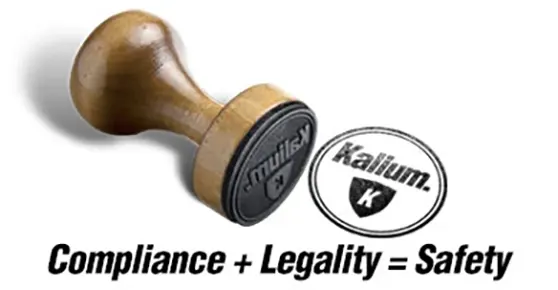
Design, programming and hosting by VisionW3.com

